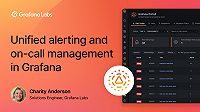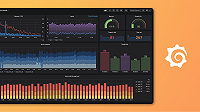Caution
As of 2025-03-11, Grafana OnCall OSS has entered maintenance mode, and will be archived on 2026-03-24. No further feature development will occur; however, we will still provide fixes for critical bugs and for valid CVEs with a CVSS score of 7.0 or higher. For more information, refer to our blog post.
Important: This documentation is about an older version. It's relevant only to the release noted, many of the features and functions have been updated or replaced. Please view the current version.
Alertmanager integration for Grafana OnCall
Note
⚠️ Legacy integration ⚠️ Integrations that were created before version 1.3.21 (1 August 2023) were marked as (Legacy) and migrated. These integrations are receiving and escalating alerts, but some manual adjustments may be required.
The Alertmanager integration handles alerts from Prometheus Alertmanager. This integration is the recommended way to send alerts from Prometheus deployed in your infrastructure, to Grafana OnCall.
Pro tip: Create one integration per team, and configure alertmanager labels selector to send alerts only related to that team
Configuring Grafana OnCall to Receive Alerts from Prometheus Alertmanager
- In the Integrations tab, click + New integration.
- Select Alertmanager Prometheus from the list of available integrations.
- Enter a name and description for the integration, click Create
- A new page will open with the integration details. Copy the OnCall Integration URL from HTTP Endpoint section. You will need it when configuring Alertmanager.
Configuring Alertmanager to Send Alerts to Grafana OnCall
- Add a new Webhook receiver to
receiverssection of your Alertmanager configuration - Set
urlto the OnCall Integration URL from previous section- Note: The url has a trailing slash that is required for it to work properly.
- Set
send_resolvedtotrue, so Grafana OnCall can autoresolve alert groups when they are resolved in Alertmanager - It is recommended to set
max_alertsto less than100to avoid requests that are too large. - Use this receiver in your route configuration
Here is the example of final configuration:
route:
receiver: "oncall"
group_by: [alertname, datacenter, app]
receivers:
- name: "oncall"
webhook_configs:
- url: <integration-url>
send_resolved: true
max_alerts: 100Complete the Integration Configuration
Complete configuration by setting routes, templates, maintenances, etc. Read more in this section
Note about grouping and autoresolution
Grafana OnCall relies on the Alertmanager grouping and autoresolution mechanism to ensure consistency between alert state in OnCall and AlertManager. It’s recommended to configure grouping on the Alertmanager side and use default grouping and autoresolution templates on the OnCall side. Changing this templates might lead to incorrect grouping and autoresolution behavior. This is unlikely to be what you want, unless you have disabled grouping on the AlertManager side.
Configuring OnCall Heartbeats (optional)
An OnCall heartbeat acts as a monitoring for monitoring systems. If your monitoring is down and stop sending alerts, Grafana OnCall will notify you about that.
Configuring Grafana OnCall Heartbeat
- Go to Integration Page, click on three dots on top right, click Heartbeat settings
- Copy OnCall Heartbeat URL, you will need it when configuring Alertmanager
- Set up Heartbeat Interval, time period after which Grafana OnCall will start a new alert group if it doesn’t receive a heartbeat request
Configuring Alertmanager to send heartbeats to Grafana OnCall Heartbeat
You can configure Alertmanager to regularly send alerts to the heartbeat endpoint. Add vector(1) as a heartbeat
generator to prometheus.yaml. It will always return true and act like always firing alert, which will be sent to
Grafana OnCall once in a given period of time:
groups:
- name: meta
rules:
- alert: heartbeat
expr: vector(1)
labels:
severity: none
annotations:
description: This is a heartbeat alert for Grafana OnCall
summary: Heartbeat for Grafana OnCallAdd receiver configuration to prometheus.yaml with the OnCall Heartbeat URL:
...
route:
...
routes:
- match:
alertname: heartbeat
receiver: 'grafana-oncall-heartbeat'
group_wait: 0s
group_interval: 1m
repeat_interval: 50s
receivers:
- name: 'grafana-oncall-heartbeat'
webhook_configs:
- url: https://oncall-dev-us-central-0.grafana.net/oncall/integrations/v1/alertmanager/1234567890/heartbeat/
send_resolved: falseNote about legacy integration
Legacy integration was using each alert from AlertManager group as a separate payload:
{
"labels": {
"severity": "critical",
"alertname": "InstanceDown"
},
"annotations": {
"title": "Instance localhost:8081 down",
"description": "Node has been down for more than 1 minute"
},
...
}This behaviour was leading to mismatch in alert state between OnCall and AlertManager and draining of rate-limits, since each AlertManager alert was counted separately.
We decided to change this behaviour to respect AlertManager grouping by using AlertManager group as one payload.
{
"alerts": [...],
"groupLabels": {
"alertname": "InstanceDown"
},
"commonLabels": {
"job": "node",
"alertname": "InstanceDown"
},
"commonAnnotations": {
"description": "Node has been down for more than 1 minute"
},
"groupKey": "{}:{alertname=\"InstanceDown\"}",
...
}You can read more about AlertManager Data model here.
After-migration checklist
Integration URL will stay the same, so no need to change AlertManager or Grafana Alerting configuration. Integration templates will be reset to suit new payload. It is needed to adjust routes and outgoing webhooks manually to new payload.
- Send a new demo alert to the migrated integration.
- Adjust routes to the new shape of payload. You can use payload of the demo alert from previous step as an example.
- If outgoing webhooks utilized the alerts payload from the migrated integration in the trigger or data template it’s needed to adjust them as well.



